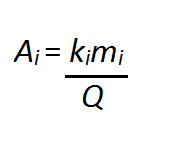Peak area decreases with increasing flow rate - FAQ
December 11, 2014
/
/
/
/
/
/
/
/
/
Question: I have tried running the same method under different flow rates and observed that the analyte peak area is lower at the higher flow rates. Is this normal?
Answer: Yes. As stated by Chromatography Today™, flow rate is inversely proportional to peak area:

where Ai is the area response of analyte i, ki is the detector response factor of analyte i, mi is the mass of analyte i which was injected, and Q is the flow rate. From the equation, we can see that peak area as a function of flow rate will not be linear. A lower flow rate will produce a wider peak because it will take more time for the analyte to pass by the detector. A wider peak means a larger area.
This phenomenon applies to concentration-sensitive detectors such as UV absorption. You can tell the difference between a concentration-sensitive detector and a mass sensitive one by setting the flow rate to zero as a peak is eluting. With the latter, detector response will immediately drop to zero.
Reference: Chromatography Help Desk, Chromatography Today™, Nov/Dec 2014, 20–21.

Answer: Yes. As stated by Chromatography Today™, flow rate is inversely proportional to peak area:

where Ai is the area response of analyte i, ki is the detector response factor of analyte i, mi is the mass of analyte i which was injected, and Q is the flow rate. From the equation, we can see that peak area as a function of flow rate will not be linear. A lower flow rate will produce a wider peak because it will take more time for the analyte to pass by the detector. A wider peak means a larger area.
This phenomenon applies to concentration-sensitive detectors such as UV absorption. You can tell the difference between a concentration-sensitive detector and a mass sensitive one by setting the flow rate to zero as a peak is eluting. With the latter, detector response will immediately drop to zero.
Reference: Chromatography Help Desk, Chromatography Today™, Nov/Dec 2014, 20–21.

